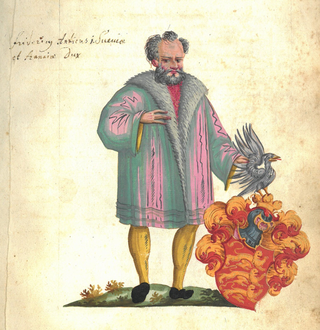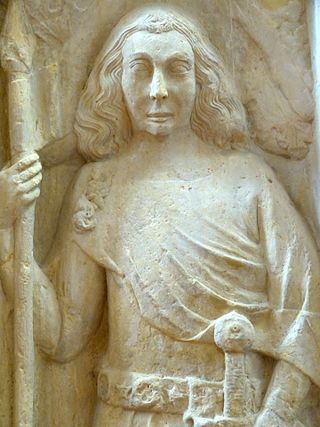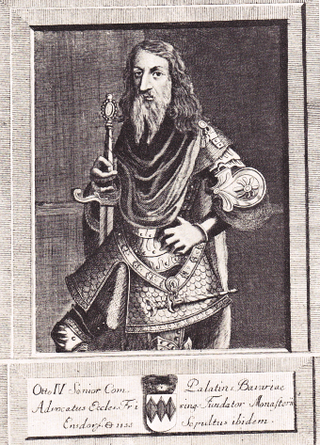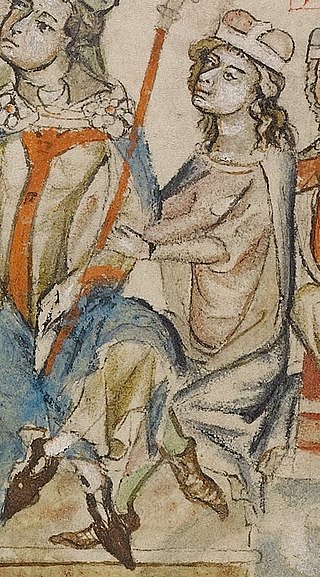Life
Louis was a son of Louis the Bearded and a member of the Franconian noble Ludowingians dynasty. He was baptized in the parish church in Altenbergen (today part of Leinatal). Around 1080, Louis and his brother Beringe founded the Schönrain Priory. In a document dated 1100, the two brothers are called "of Schauenburg", after a castle which their father had built near Friedrichroda.
Louis continued the policy of his father of expanding his influence into the Thuringian Basin by founding castles and monasteries. His marriage to Adelheid of Stade, widow of the Saxon count palatine Frederick III, brought him into the highest levels of the German aristocracy. Louis built the castles of Wartburg, which became the nucleus of the Landgraviate of Thuringia, around 1080 and Neuenburg around 1100. [1] Louis himself did not use the title of landgrave; his son Louis I was the first member of the dynasty to use that title.
During the Great Saxon Revolt, Louis first sided with Emperor Henry IV, who probably made him a count in 1080. Later, he supported the future archbishop Ruthard of Mainz against the king. In 1085, he founded the monastery of Reinhardsbrunn with monks from Hirsau Abbey. In 1092, Pope Urban II confirmed him as advocatus of the monastery and exempted the monastery of episcopal jurisdiction, making it subject only to the Holy See. In 1094, Urban granted it the right to freely elect its abbot. [1]
In 1094 or 1095, Bishop Walram of Naumburg wrote to Louis to persuade him to return to the emperor's side, but Louis had Bishop Herrand of Halberstadt give a reply to the learned bishop on his behalf. [2]
Wolfgang Hartmann has proposed the hypothesis that, considering his hostile stance towards the Salians, among the statues of famous church founders in the Naumburg Cathedral there must be statues of Louis and his wife.
Legend
According to legend, Louis received his nickname "the Jumper" when he boldly leaped into a river. He was attempting to take possession of the County Palatine of Saxony, that is, the area west of the river Saale and north of the Unstrut. To this end, he stabbed the ruling Count Palatine, Frederick III. He was arrested and incarcerated in Giebichenstein Castle in Halle. After three years in captivity, he expected to be executed. He escaped by leaping from the castle tower into the river Saale, where a servant was waiting for him with a boat and his favourite horse, a snow-white horse named Swan. As atonement for murdering Frederick, he built the St. Ulrici church in Sangerhausen and later he founded Reinhardsbrunn Abbey.
Another legend relates how he came to build the Wartburg. He found the location in 1067, while he was hunting in the area. He saw the mountain and exclaimed: Wait, mountain, thou shalt bear me a castle!. However, this mountain was outside his territory. To circumvent this problem, he had his men carry dirt from his own territory and dump it on the mountain. He then had twelve of his most loyal knights stand on that spot, stick their swords in the ground and swear that the soil they were standing on, rightfully belonged to Louis.

Henry Raspe was the Landgrave of Thuringia from 1231 until 1239 and again from 1241 until his death. In 1246, with the support of the Papacy, he was elected King of Germany in opposition to Conrad IV, but his contested reign lasted a mere nine months.

Frederick I before 21 July was Duke of Swabia from 1079 to his death, the first ruler from the House of Hohenstaufen (Staufer).
Albert I was a Duke of Saxony, Angria, and Westphalia; Lord of Nordalbingia; Count of Anhalt; and Prince-elector and Archmarshal of the Holy Roman Empire. Even though his grandfather Albert the Bear had held the Saxon dukedom between 1138 and 1142, this Albert is counted as the first.

Conrad was the landgrave of Thuringia from 1231 to 1234 and the fifth Grand Master of the Teutonic Order from 1239 to 1240. He was the first major noble to join the military order.

Hermann I, Landgrave of Thuringia and Count Palatine of Saxony, was the second son of Louis II, Landgrave of Thuringia, and Judith of Hohenstaufen, the sister of Emperor Frederick Barbarossa.

Henry V, the Elder of Brunswick, a member of the House of Welf, was Count Palatine of the Rhine from 1195 until 1212.
Theodoric I, called the Oppressed, was the Margrave of Meissen from 1198 until his death. He was the second son of Otto II, Margrave of Meissen and Hedwig of Brandenburg.

Louis I was ruler of Thuringia from 1123 to 1140.

Otto V, Count of Wittelsbach, also called Otto IV, Count of Scheyern, was the second son of Eckhard I, Count of Scheyern and Richardis of Carniola and Istria. Otto named himself Otto of Wittelsbach, after Wittelsbach Castle near Aichach. He served Henry V, Holy Roman Emperor, in his first Italian Expedition in 1110–1111. Emperor Henry V already addressed him as Otto Count of "Witlinesbac" in a document in 1115. From 1120 onwards, he was Count palatine of Bavaria.

Otto I, a member of the House of Andechs, was Duke of Merania from 1204 until his death. He was also Count of Burgundy from 1208 to 1231, by his marriage to Countess Beatrice II, and Margrave of Istria and Carniola from 1228 until his death.
Beatrice II reigned as Countess Palatine of Burgundy from 1205 until her death. She was a member of the Swabian Hohenstaufen dynasty, the daughter of Count Otto I of Burgundy and Margaret, Countess of Blois, thereby a granddaughter of Emperor Frederick Barbarossa.
Ulric II was the Margrave of Istria from 1098 until circa 1107 and Carniola from 1098 until his death. He was the second son of Ulric I and Sophia, a daughter of Bela I of Hungary.

Berthold III, a member of the Bavarian House of Andechs, was Margrave of Istria from 1173 until his death.
Jutta of Thuringia was the eldest daughter of Landgrave Hermann I of Thuringia and his first wife, Sophia of Sommerschenburg, a daughter of Fredrick II of Sommerschenburg.
Engelbert III, Count of Gorizia was a member of the Meinhardiner dynasty. He ruled the County of Gorizia from 1191 until his death.
Herman II, Count of Weimar-Orlamünde was a member of the House of Ascania. He ruled the County of Weimar-Orlamünde from 1206 until his death.

Matilda of Andechs was a daughter of Margrave Berthold I of Istria and his first wife, Hedwig of Dachau-Wittelsbach, daughter of the Bavarian Count palatine Otto IV of Scheyern.

Ludwig II, Landgrave of Thuringia, nicknamed Louis the Iron.
Siegfried III, Count of Weimar-Orlamünde was a member of the House of Ascania and a ruling Count of Weimar-Orlamünde.
Jonathan R. Lyon is an American historian of medieval Europe. He is a professor of history at the University of Vienna.
This page is based on this
Wikipedia article Text is available under the
CC BY-SA 4.0 license; additional terms may apply.
Images, videos and audio are available under their respective licenses.










